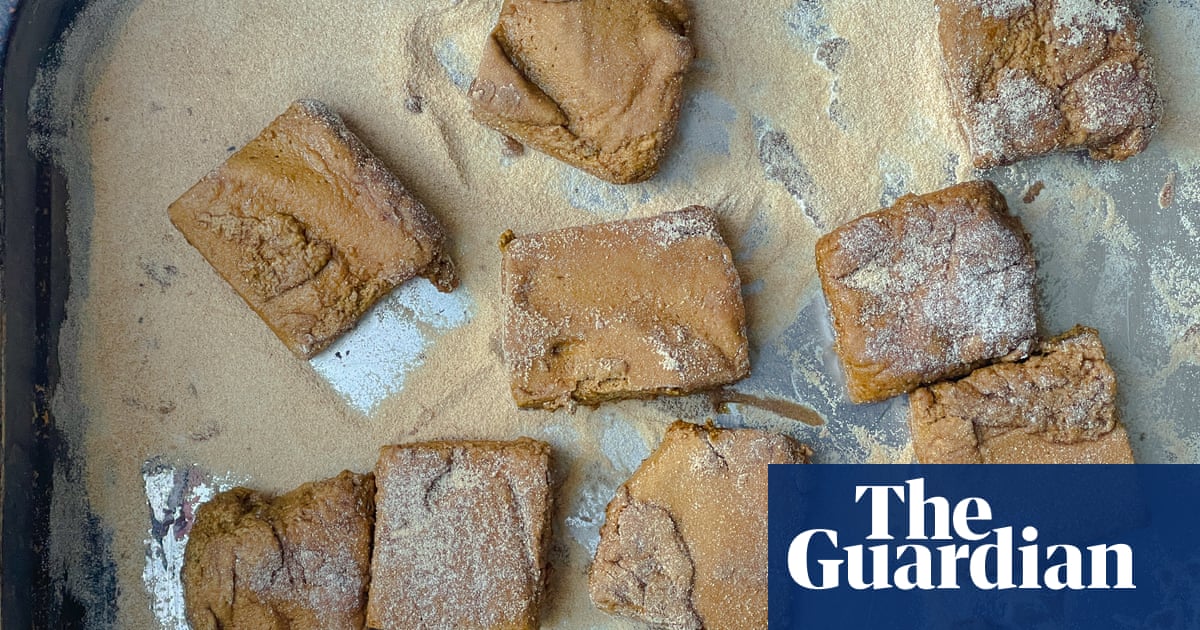Marshmallows are a magical sweet, with vivid, popping colours and an unbelievably soft, squishy texture. Even after 25 years as a chef, I still love making them and, like most things, they taste better homemade.
If you’ve cooked something like a creme brulee, mayo or carbonara, and have a few egg whites spare, today’s recipe is a fun and delicious way to turn waste into taste.
I’m omnivorous now, but when I turned vegetarian at the age of 14 my mum would forcefeed me a spoon of black strap molasses every morning to boost my iron intake. Treacle and back strap molasses are byproducts of sugar refining, and a much healthier alternative, being full of vitamins, nutrients and minerals, including iron, calcium and potassium. And now that my daughter is mostly vegetarian, I garnish her porridge with treacle or molasses each morning, too.
Inspired by my mother, I thought it would be a good idea to develop this marshmallow recipe with black treacle, for a slightly more nourishing take on marshmallows that I can share with my daughter. It has a strong and complex flavour that is a bit of an acquired taste, but one that’s well worth acquiring for the extra nutrients. If you are new to treacle, taste it first: if you find it too strong, mix it with either sugar, honey or maple syrup to reduce its intensity, or acquire the taste by adding it sparingly to your porridge as I did. The addition of ground fennel, meanwhile, gives these black treacle marshmallows a delicious liquorice note.
This recipe is an adaptation ofDominique Ansel’s reliable method. Make sure you use a pan that’s large enough to allow the melted sugar to boil up the sides, because when you add the gelatine and water, it will rise considerably.
To check if the sugar has reached the hard ball stage, or 125C (260F), without a thermometer, use the so-called cold water test: drop a little syrup into a bowl of cold water. If it forms a firm but pliable ball that holds its shape without flattening, it’s ready.
MakesAbout 12
Neutral oil, for greasingCornflour, for dusting100g sugar100g black strap molasses1 pinch salt30g honey160g water– 80g for blooming the gelatine, plus 80g for syrup12g gelatine powder3 egg whites2 tsp ground fennel seeds(optional)Icing sugar or finely ground brown sugar, for coating
Brush a 20cm square tin with a thin layer of oil, then dust it generously with cornflour.
In a saucepan, combine the sugar, black strap molasses, salt and half the water, and fit the pan with a sugar thermometer, making sure the tip doesn’t touch the bottom. Bring to a boil on a medium heat, then pour in the honey – do not stir it! Leave to cook for eight to 12 minutes, until the mix hits the hard ball stage, or 125C, then take off the heat.
In a small bowl, stir the gelatine powder into the remaining water until dissolved, then carefully add to the sugar mix – it will bubble up – then whisk until smooth.
In a large bowl, whisk the egg whites to soft peaks. Beating continuously, slowly drizzle in the hot sugar syrup down the side of the bowl, and keep whisking until thick and glossy. Add the ground fennel, if using, and whisk again to combine.
Pour the mix into the greased tin and tap firmly on the counter to knock out any air bubbles. Leave at room temperature to set for two to three hours, until firm to the touch.
Dust the top of the set marshmallow mix with cornflour, then turn it out on to a board coated with a 50:50 mix of cornflour and icing sugar (or finely ground brown sugar) and another teaspoon of ground fennel, if using. Cut into cubes, then roll in the coating to stop them sticking together.
Store at room temperature in an airtight container for up to a week, or in the fridge for up to a month.
